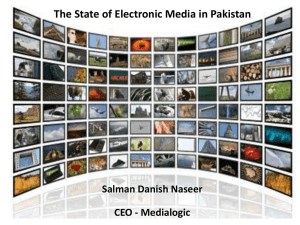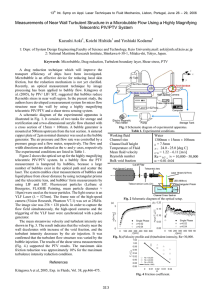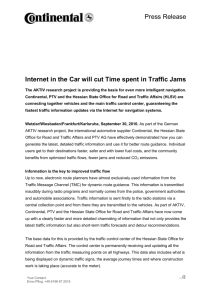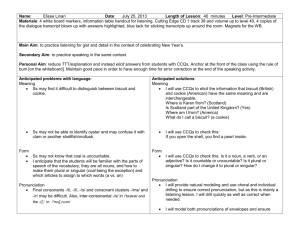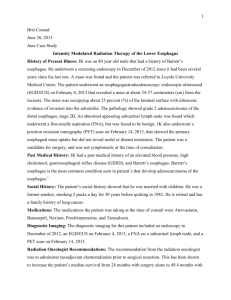PTV: Intelligent Personalised TV Guides Paul Cotter & Barry Smyth
advertisement
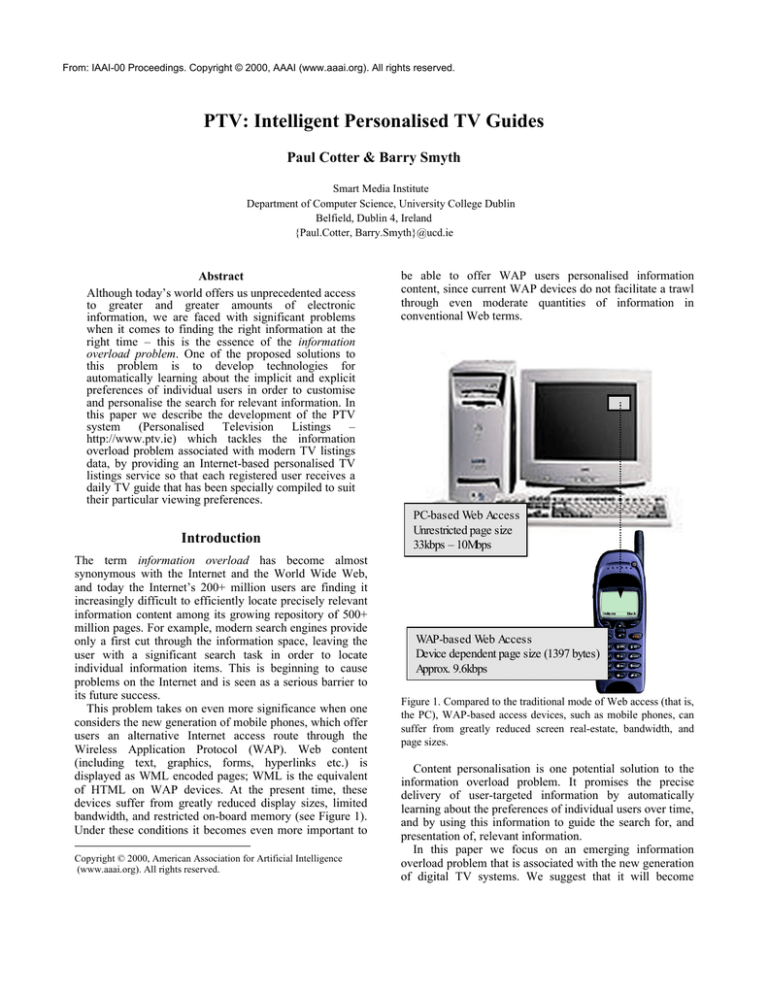
From: IAAI-00 Proceedings. Copyright © 2000, AAAI (www.aaai.org). All rights reserved.
PTV: Intelligent Personalised TV Guides
Paul Cotter & Barry Smyth
Smart Media Institute
Department of Computer Science, University College Dublin
Belfield, Dublin 4, Ireland
{Paul.Cotter, Barry.Smyth}@ucd.ie
Abstract
Although today’s world offers us unprecedented access
to greater and greater amounts of electronic
information, we are faced with significant problems
when it comes to finding the right information at the
right time – this is the essence of the information
overload problem. One of the proposed solutions to
this problem is to develop technologies for
automatically learning about the implicit and explicit
preferences of individual users in order to customise
and personalise the search for relevant information. In
this paper we describe the development of the PTV
system
(Personalised Television
Listings –
http://www.ptv.ie) which tackles the information
overload problem associated with modern TV listings
data, by providing an Internet-based personalised TV
listings service so that each registered user receives a
daily TV guide that has been specially compiled to suit
their particular viewing preferences.
Introduction
The term information overload has become almost
synonymous with the Internet and the World Wide Web,
and today the Internet’s 200+ million users are finding it
increasingly difficult to efficiently locate precisely relevant
information content among its growing repository of 500+
million pages. For example, modern search engines provide
only a first cut through the information space, leaving the
user with a significant search task in order to locate
individual information items. This is beginning to cause
problems on the Internet and is seen as a serious barrier to
its future success.
This problem takes on even more significance when one
considers the new generation of mobile phones, which offer
users an alternative Internet access route through the
Wireless Application Protocol (WAP). Web content
(including text, graphics, forms, hyperlinks etc.) is
displayed as WML encoded pages; WML is the equivalent
of HTML on WAP devices. At the present time, these
devices suffer from greatly reduced display sizes, limited
bandwidth, and restricted on-board memory (see Figure 1).
Under these conditions it becomes even more important to
Copyright © 2000, American Association for Artificial Intelligence
(www.aaai.org). All rights reserved.
be able to offer WAP users personalised information
content, since current WAP devices do not facilitate a trawl
through even moderate quantities of information in
conventional Web terms.
PC-based Web Access
Unrestricted page size
33kbps – 10Mbps
WAP-based Web Access
Device dependent page size (1397 bytes)
Approx. 9.6kbps
Figure 1. Compared to the traditional mode of Web access (that is,
the PC), WAP-based access devices, such as mobile phones, can
suffer from greatly reduced screen real-estate, bandwidth, and
page sizes.
Content personalisation is one potential solution to the
information overload problem. It promises the precise
delivery of user-targeted information by automatically
learning about the preferences of individual users over time,
and by using this information to guide the search for, and
presentation of, relevant information.
In this paper we focus on an emerging information
overload problem that is associated with the new generation
of digital TV systems. We suggest that it will become
almost impossible for people to cope with the promise of
hundreds of TV channels and thousands of TV programmes
daily, and that traditional TV guides will fail to provide any
practical assistance. We present PTV (http://www.ptv.ie) as
a real solution to this problem. In short, PTV is an
innovative Internet service that uses content personalisation
techniques to automatically learn about the TV viewing
preferences of individual users to provide them with highly
customised and personalised daily TV guides. In particular,
we focus on two versions of PTV, a fully deployed Webbased system and a newly developed version for WAPbased mobile phones (making PTV one of the world’s first
fully personalised WAP information services for the mobile
phone market).
Problem Description
With the arrival of new cable and satellite television
services, and the next generation of digital TV systems, we
will soon be faced with an unprecedented level of
programme choice. Tens of TV channels today will become
hundreds of channels tomorrow, and thousands soon after
that. Even today, in Europe and the US, many subscribers
have access to upwards of one hundred channels,
broadcasting over 2500 programmes per day. The service
providers tell us that this new level of channel choice will
revolutionise the way we use and view TV, but they rarely
tell us of the pit-falls that lie just around the corner. These
developments will introduce a whole new set of information
overload issues since we have not yet developed the tools
that are necessary to deal with this new level of choice. It
will become increasingly difficult to find out what
programmes are on in a given week, never mind locating a
small set of relevant programmes for a quiet evening’s
viewing.
surfing” will become a thing of the past as a means for
finding out what’s on now – while a rapid surf through 20
or 30 channels takes an acceptable few minutes, surfing
through 200 or 300 channels could take a number of hours.
Of course the digital TV vendors are aware of such
issues, and do recognise the beginnings of a serious
information overload problem. They are now offering
electronic programme guides (EPGs) to help users to
navigate through the TV listings maze. These guides
provide an on-screen menu system for searching online TV
listings information. Figure 2 shows an example of Sky
Digital’s EPG, listing programmes on 10 channels for a 1
hour time-slot. However, Sky’s full 60 channel line-up
requires up to 6 screens of information for each viewing
hour (that is, over 140 screens per viewing day). Clearly the
burden of search remains with the user and these EPGs face
the same problems of scale as existing TV guides.
Some EPG’s attempt to help the user further by providing
a genre-based view of the listings data. For example, a user
might request a list of all comedies, or drams, or films that
are on a given day, and this will help to focus the search
further. However, these static genre-based approaches are
still relatively crude, and at best provide only short-term
relief from the information overload problem, after all,
there may still be hundreds of comedies showing on a given
night, and many of these may be of no interest to a given
user.
Application Description
The PTV project is motivated by the belief that the TV
listings domain can benefit greatly from an EPG that
incorporates content personalisation techniques as a means
of filtering and customising TV listings information for
individual users (Kay 1995; Perkowitz and Etzioni 1997).
In this section we describe the PTV system, focusing in
particular on how it produces personalised TV guides by
integrating user profiling, case-based reasoning, and
collaborative profiling techniques.
Hardware & Software
Figure 2. An example electronic programme guide (EPG) courtesy
of BskyB.
Consider the traditional TV guide, which lists programming
information for perhaps a week in advance. The days of a
slim, easy to digest 30-page volume are numbered. Instead
we are faced with TV guides of telephone book proportions,
running into hundreds of pages of indigestible schedule
charts. Moreover, the way that we interact with our TV sets
will also have to change. For better or for worse, “channel
PTV is a Java-based client-server system and includes a
specially designed optimised, multi-threaded server and
dynamic HTML/WML page generator, plus all of the
artificial intelligence and user profiling components
necessary for personalisation. It currently runs on
WindowsNT on an Intel 450MHz processor with 64MB of
RAM and has been stress-tested beyond 7 million hits per
month without any substantial performance degradation.
System Architecture
PTV users can register, login, and view their personalised
TV guides as specially customised HTML pages (for
conventional PC-based access) or as WML pages (for
mobile phone access). The architecture of PTV (Figure 3)
does not depend on the mode of access (PC vs. WAP-based
device) and all user interaction is handled via HTTP. The
heart of the system lies with its server-side components,
which handle all the main information processing functions
such as user registration and authentication, user profiling,
guide compilation, and the all-important programme
recommendation and grading.
ER
Genre
Country
Language
Cast
:
USER#1725
Channels
BBC1, C4
SKY1,…
+Progs
ER, …
-Progs
Friends,…
Keywords Drama,…
Times
PrimeTime
:
:
Medical
Drama
USA
English
Anthony
Edwards
:
Programme
Case-Base
PTV SERV ER
Profile DB
Recommender
Schedule DB
Compiler
Scheduler
Schedule Entry#1276
Title
ER
Channel
RTE1
Date
22/1/00
Start
21:30
End
22:30
Details
Dr. Green…
:
:
Translator
Profiler
PTV CLIENT
Figure 3. An overview of the PTV system architecture.
Profile Database & Profiler: The key to PTV’s
personalisation facility is an accurate database of user
profiles. Each profile encodes the TV preferences of a
given user, listing channel information, preferred viewing
times, programme and genre preferences, guide preferences
etc. (see Figure 3). Preliminary profile information is
collected from the user at registration time in order to
bootstrap the personalisation process. However, the
majority of information is learned from grading feedback
provided by the user; each recommended programme is
accompanied with grading icons or links that allow the user
to explicitly evaluate the proposed recommendation (see
also Section 4.1).
Programme Case-Base: This database contains the
programme content descriptions (programme cases). Each
entry describes a particular programme using features such
as the programme title, genre information, the creator and
director, cast or presenters, the country of origin, and the
language; an example programme case for the comedy
‘Friends’ is shown in Figure 3. This information repository
is
crucial
for
the
content-based
(case-based)
recommendation component of PTV (see Section 4.2).
Schedule Database: This database contains TV listings
for all supported channels. Each listing entry includes
details such as the programme name, the viewing channel,
the start and end time, and typically some text describing
the programme in question (see the schedule entry example
in Figure 3). The schedule database is constructed
automatically from electronic schedule resources.
Recommender: The recommender component is the
intelligent core of PTV. Its job is to take user profile
information and to select new programmes for
recommendation to a user. In the next section we will
explain how PTV uses a hybrid recommendation approach
that
combines
content-based
and
collaborative
recommendation strategies (see Sections 4.2 and 4.3).
Guide Compiler: To compile a personalised guide for a
user, PTV uses two programme lists: (1) programmes listed
as positive in the user’s profile, along with those
programmes selected for recommendation (that do not
occur in the profile); (2) a list of programmes to be aired on
the specified date by channels listed in the user’s profile.
The intersection of these lists is the set of programmes that
will finally appear in the personalised guide.
Guide Translator: The guide compiler produces a
generic guide format, which is automatically converted into
a HTML or WML page by the guide translator as
appropriate. While individual guides are converted into
single HTML pages for the Web, they are converted into
multiple WML pages (or cards) for mobile phone usage;
this is necessary to solve the problems of limited
presentation space (and memory space) that exist on current
WAP phones
Problem Description
Artificial Intelligence techniques are central to the success
of the PTV system. Specifically, the ability to accurately
personalise the television guide of an individual user relies
on the availability of an accurate model of this user (user
profiling), and an ability to relate this profile to relevant
programme content (programme recommendation). In this
section we outline PTV’s user profiling component and its
content recommendation strategies
Acquiring User Profiles
The success of PTV depends ultimately on the quality of its
personalised guides, and this depends largely on the quality
of the user profiles and their ability to represent the viewing
preferences of users (Jennings and Higuchi 1993; Kay
1995; Perkowitz and Etzioni 1997)). In PTV each user
profile contains two types of information: domain
preferences and programme preferences. The former
describe general user preferences such as a list of available
TV channels, preferred viewing times, subject keywords
and genre preferences, and guide format preferences.
Programme preferences are represented as two lists of
programme titles, a positive list containing programmes that
the user has liked in the past, and a negative list containing
programmes that the user has disliked.
Registration
Preferences Input
+
Channel/Time
Updates
through a set of grading icons listed beside guide
programmes. PTV’s profiler uses this information to
automatically alter a user’s profile in a number of ways.
The simplest modification is to update the programme
preference lists by adding positively or negatively graded
programmes to the appropriate list. However, the domain
preferences can also be altered. For example, viewing time
preferences can be adjusted if a user frequently prefers
prime-time programmes to morning shows. In general, this
long-term feedback connection between user and system is
vital if PTV is to maintain an accurate picture of each user
over time.
Figure 4 outlines how user profiles are updated in the
Web-based PTV system. A similar scenario operates in the
WAP-based version of PTV except that preference and
grading options require a number of individual pages, rather
that having a single preferences page or integrating the
grading icons with the main guide pages as in the Webbased version (see Section 5 for further details and example
screen shots).
A Content-Based Recommendation Approach
Programme Updates
PTV Guide Server
Profile Adapter
Grading Icons
Figure 4. User profiles and feedback in PTV (Web-based).
Profile information is gathered in two ways. Users are
encouraged to manually update their profiles directly by
specifying viewing preferences. However, while manual
profile editing has its advantages (usually in terms of profile
accuracy) it is a burden for the users. In particular, we have
found that users are happy to provide fairly complete
domain preferences but tend to provide only limited
programme preferences. For this reason, PTV includes a
profile update facility that is driven by direct user feedback
Ultimately in PTV, personalising a given user’s TV guide
boils down to recommending the right programmes for that
user given their various viewing constraints. PTV harnesses
two complementary recommendation strategies to base its
recommendations on the programmes that a given user has
liked in the past (case-based or content-based) and on the
programmes that similar users like (collaborative). In this
section we look at the more traditional content-based (or
case-based) approach (Watson 1997) and in the following
section we will look at the complementary collaborative
recommendation strategy.
The basic philosophy in content-based recommendation
is to recommend items that are similar to those items that
the user has liked in the past; see also (Balabanovic and
Shoham 1997; Hammond et al. 1996; Smyth and Cotter
1999). For PTV, this means recommending programmes
that are similar to the programmes in the positive
programme list and dissimilar to those in the negative
programme list. Three components are needed for contentbased recommendation: (1) content descriptions for all TV
programmes (see the programme case-base in Section 2 and
Figure 3); (2) a compatible content description of each
user’s profile; (3) a procedure for measuring the similarity
between a programme and a user.
PTV’s programme case-base has already been outlined
(Section 3.2) and an example case is shown in Figure 3.
Each case is described as a set of features and the similarity
between two cases can be defined as the weight sum of the
similarity between corresponding case features. However,
there is no direct means of computing the similarity
between a case and a user profile, as user profiles are not
described as a set of case features. Instead each raw user
profile is converted into a feature-based representation
called a profile schema. Basically, the profile schema
corresponds to a content summary of the programme
preferences contained in a user profile, encoded in the same
features as the programme cases. The similarity between a
profile and a given programme case can then be computed
using the standard weighted-sum similarity metric as shown
Schema(u)
p
th
in equation 1; Where fi
and fi are the i features of the
schema and the programme case respectively.
Schema(u) p
1. Pr gSim(Schema (u ),p ) = ∑ w i • sim f i
, fi
A problem with content-based methods is the knowledgeengineering effort required to develop case representations
and similarity models. Furthermore, because content-based
methods make recommendations based on item similarity,
the newly recommended items tend to be similar to the past
items leading to reduced diversity. In the TV domain this
can result in narrow recommendation lists, for example, a
lot of comedies if the majority of profile programmes are
comedies.
A Collaborative Recommendation Approach
Collaborative recommendation methods such as automated
collaborated filtering are an alternative to content-based
techniques. Instead of recommending new items that are
similar to the ones that the user has liked in the past, they
recommend items that other similar users have liked
(Balabanovic and Shoham 1997; Billsus and Pazzani 1998;
Goldberg et al. 1992; Konstan et al. 1997; Maltz and
Ehrlich 1995; Shardanand and Maes 1995). And instead of
computing the similarity between items, we compute the
similarity between users, or more precisely the similarity
between user profiles. In PTV the recommendations for a
target user are based on the viewing preferences of the k
most similar users.
PTV computes user similarity by using a simple graded
difference metric shown in equation 2; where p(u) and p(u’)
are the ranked programmes in each user’s profile, and
r ( p iu ) is the rank of programme pi in profile u. The possible
grades range from –2 to +2 and missing programmes are
given a default grade of 0. Of course this is just one
possible similarity technique that has proved useful in PTV,
and any number of techniques could have been used, for
example statistical correlation techniques such as Pearson’s
correlation coefficient (see eg., Billsus and Pazzani 1998).
∑ r (p ) − r (p )
2. PrfSim ( u , u ’) =
3. PrgRank (p, u ) =
p (u )∪ p (u ’)
u
i
u’
i
4 • p (u ) ∪ p (u ’)
∑ Pr fSim (u, u’)
u ’∈U
Once PTV has selected k similar profiles for a given target
user, a recommendation list is formed from the programmes
in these similar profiles that are absent from the target
profile. This list is then ranked and the top r programmes
are selected for recommendation. The ranking metric is
shown in equation 3; U is the subset of k nearest profiles to
the target that contain a programme p. This metric biases
programmes according to their frequency in the similar
profiles and the similarity of their recommending user. In
this way popular programmes suggested by very similar
users tend to be recommended.
Collaborative filtering is a powerful technique that solves
many of the problems associated with content-based
methods. For example, there is no need for content
descriptions or sophisticated case similarity metrics. In fact,
high quality recommendations, that would ordinarily
demand a rich content representation, are possible.
Moreover, recommendation diversity is maintained as
relevant items that are dissimilar to the items in a user
profile can be suggested.
Collaborative filtering does suffer from some
shortcomings. There is a startup cost associated with
gathering enough profile information to make accurate user
similarity measurements. There is also a latency problem in
that new items will not be recommended until these items
have found their way into sufficiently many user profiles.
This is particularly problematic in the TV domain because
new and one-off programmes occur regularly and do need
to be considered for recommendation even though these
programmes will not have made it into any user profiles.
The key to PTV’s success is the use of a combined
recommendation approach. For a given guide, a selection of
programmes is suggested, some are content-based
recommendations (including new or one-off programmes)
while others are collaborative recommendations. In
particular, recommendation diversity is ensured through the
use of collaborative filtering and the latency problem can be
solved by using content-based methods to recommend new
or one-off programmes.
System Demonstration
In this section we look at the use of the PTV system by a
new user, stepping through each of the basic stages, from
initial registration through to guide viewing. To avail of
PTV’s personalisation facilities, each new user must
register an account with PTV. In addition to submitting the
usual username and password details the user is also asked
to provide initial profile information (as discussed in
Section 4.2) and this is shown by the screen shots in Figure
5. Figure 5(a) shows the preferences screen for the webbased version of PTV, whereas Figure 5(b) shows the
equivalent screens in the WAP-based version.
The presentation restrictions introduced by the current
generation of WAP enabled mobile phone should now be
clear. As a result the single-screen preferences of the Webbased version is replaced by multiple screens in the WAPbased version.
Incidentally, access to the preferences information shown
in Figure 5 is not restricted to registration time. Users can
access and edit their profiles at any time as a means of
supplementing any updates made by the programme
grading process.
Combined channel, prog., and keyword preferences
(a) Web-based Preferences Screen
Preferences menu
Channel Preferences
Combined prog., channel, time, and grading information
(a) Web-based PTV Guide
Programme title, channel,
and time information
Programme
details
Prog. Preferences
Keyword Preferences
Programme
grading
(b) WAP-based Preferences Screens
(b) WAP-based PTV Guide
Figure 5. The initial profile screen during user registration.
Figure 6. A personalised guide for today’s TV.
Once a user has registered they can access their
personalised guides. The main interface has been kept
simple and all of the site features and guide options are
available from a simple menu on both the Web and WAP
versions. The user can receive personalised guides for
programmes on today or tomorrow, as well as what’s on
now and next, a list of the top 10 programmes (as compiled
from the user profiles currently in the system), a wide range
of subject-specific guides (eg, comedy, drama, film, etc),
plus of course full TV listings.
Figure 6(a&b) shows examples of a personalised daily
guide from the Web and WAP versions of PTV. On the
Web-based version, Figure 6(a), we can see four
programmes from BBC, Channel 4 and UTV; the full guide
contains about 10 programmes. Two of the visible
programmes have been selected for this guide because the
user is known to enjoy them (Friends and The Bill are both
listed in the user’s profile). Two of the programmes
(Eastenders and Auntie’s Sporting Bloomers) are
recommendations based on this user’s profile, and as such
they are annotated with grading icons so that the user can
provide feedback on the quality of these recommendations.
Similar information is carried by the WAP version but
because of presentation and memory restrictions it is not
possible to display complete guide information (programme
name, details, channel, time, and grading options) on a
single screen. Instead, the main guide screen contains only
programme title, channel, and time information as shown.
A user is free to request more information on any particular
programme by a simple selection, and at this point can
continue on to grade that programme as desired; see Figure
6(b).
PTV’s personalisation facility is also used to compile a
variety of so-called themed guides which are analogous to
the genre-based guides used by modern EPGs (see Section
2). These guides are not compiled with respect to a
particular user but rather with respect to a particular theme.
For example, PTV provides themed guides for comedy,
sport, news, drama, soap operas, chat shows etc, and the
programmes for these guides are automatically selected
using PTV existing recommendation engine by creating
profiles to represent ‘virtual’ users with specialized interests
in a particular theme.
Deployment, Evaluation, and Maintenance
PTV was originally developed as part of a three-year basic
research project in the Department of Computer Science at
University College Dublin, Ireland. The resulting
personalisation technology was re-implemented as a
commercially viable personalisation engine during 1999
(approximately 9 person months). A well developed set of
tools and systems now exist for rapidly developing new
commercial versions of PTV to suit a wide range of client
needs. For example, the latest development of the WAPbased version of PTV required only 8 person-weeks of
development time.
Application Use and Payoff
PTV went live in January 1999 and the number of
registered users has grown to nearly 20,000 with about
50,000 personalised guides generated per month.
Furthermore, as yet PTV has not been publicised, so its
current popularity is based largely on word of mouth and
unsolicited press coverage. In fact, since the launch the site
has received a Yahoo! Site of the Month award plus many
favourable press reviews from Irish and UK magazines and
newspapers including ComputerActive, Dot.ie, PC Live,
Business & Finance, the Sunday Business Post, and the
Irish Times. PTV was a finalist in the Irish Golden Spider
Internet Awards under the best use of technology category.
PTV has been so successful that a campus company
called Changing Worlds (http://www.changingworlds.com)
has been established in University College Dublin to market
the PTV system and its underlying personalisation
technology. For example, a re-branded version of PTV has
already been licensed and launched on the Ireland.com
portal site (http://www.ireland.com) run by the Irish Times
newspaper group. This re-branded version is called MyTV
and since its launch in August 1999 has attracted
approximately 8,000 new users to produce approximately
40,000 personalised guides per month. MyTV adds a
valuable ‘sticky’ content service to the ireland.com site and
helps to secure user loyalty and increase traffic levels.
Personalisation Quality
Poor
3%
Satisfactory
36%
Good
61%
Ease of Use
Satisfactory
23%
Poor
1%
Good
76%
Speed
Poor
12%
Satisfactory
36%
Good
52%
Figure 7. User survey summary results.
End-User Evaluation
Of course, from a scientific viewpoint, the big question
concerns the accuracy of PTV’s personalisation facility.
From January to June, 1999, real users carried out an
extensive and detailed study on PTV. In total 310 users
completed a comprehensive questionnaire regarding all
aspects of PTV including its personalisation quality, speed,
and ease of use, the results of which are summarised in the
pie charts shown in Figure 7; see Smyth & Cotter (1999)
for further experimental results.
Clearly, the results are extremely positive. Critically,
only 3% of users found the personalised guides to be of
poor quality and 99% of users found the site to be easy to
use as a source of TV listings. Moreover, 88% of users
found the response time to be acceptable, which we view
very positively, especially considering the fact that PTV’s
pages are created dynamically and the limited speed of
today’s Internet.
Maintenance
The PTV systems are designed to have minimal ongoing
maintenance requirements. For example the maintenance of
the user profiles and the programme schedules is fully
automatic. In fact, in our experience, the only manual
maintenance that is required involves the addition of new
programme cases and the addition of new channels and
cable-regions. Even a relatively inexperienced user can
manage both of these maintenance options by using PTV’s
in-built tools.
Conclusions
We believe that PTV represents a convergence of
technologies that provides an effective solution to the very
real problem of providing people with relevant TV listings
information as digital TV becomes a reality. PTV
personalises TV information to meet the viewing
preferences of individual users by integrating two different
information-filtering strategies, case-based reasoning and
collaborative filtering, with user profiling techniques. The
resulting hybrid personalisation technique allows
programme recommendations to be made according to the
type of programmes a target user has enjoyed in the past as
well as the programmes that other similar users have
enjoyed.
To date this technology has been deployed on the Internet
as the PTV (www.ptv.ie) and MyTV (www.ireland.com)
web sites. These applications have proven to be successful
with widespread adoption across Irish Internet market. In
the near future, a WAP version of PTV will be formally
launched and we believe a similar success story will unfold
as mobile phone users recognise the real benefits of highquality content personalisation on their restricted mobile
handsets. In fact, we argue that traditional TV listings
services are not appropriate given the screen and bandwidth
limitations of the current generation of WAP devices – a
personalised service such as PTV is the best available
solution.
Of course PTV’s personalisation technology is not
restricted to personalising TV listings content. The PTV
systems are built around a content personalisation engine
that can be readily adapted to practically any source of
information content and Changing Worlds is currently using
this technology to develop the next generation of intelligent,
personalised information services.
References
Balabanovic M., Shoham Y. 1997. FAB: Content-Based
Collaborative Recommender. Communications of the
ACM,40(3): 66-72.
Billsus, D. & Pazzani, M. J. 1998. Learning collaborative
Information Filters. In Proceedings of the International
Conference on Machine Learning, Wisconsin, USA.
Goldberg D., Nichols D., Oki B. M., Terry D. 1992. Using
Collaborative Filtering to Weave an Information Tapestry.
Communications of the AC 35(12) 61-70.
Hammond, K. J., Burke, R., and Schmitt, K. 1996. A CaseBased Approach to Knowledge Navigation. In Case-Based
Reasoning Experiences Lessons and Future Directions.
MIT Press, 125-136
Jennings, A. & Higuchi, H. 1993. A user model neural
network for a personal news service. User Modeling and
User-Adapted Information: 3(1).1-25
Kay J. 1995. Vive la Difference! Individualised Interaction
with Users. In Proceedings of the 14th International Joint
Conference on Artificial Intelligence, 978-984. Menlo Park,
Calif.: International Joint Conferences on Artificial
Intelligence Inc.
Konstan J. A., Miller B. N., Maltz D., Herlocker J. L.,
Gordan L. R., Riedl J. 1997. Grouplens: Applying
Collaborative Filtering to Usenet News. Communications of
the ACM. 40(3) 77-87.
Maltz D., Ehrlich K. 1995. Pointing the Way: Active
Collaborative Filtering. In Proceedings of the ACM
Conference on Human Factors in Computing Systems (CHI
’95). ACM Press, New York, N.Y., 202-209.
Perkowitz, M. & Etzioni, O. 1997. Adaptive Web Sites: An
th
AI Challenge. In Proceedings of the 15 International Joint
Conference on Artificial Intelligence. Menlo Park, Calif.:
International Joint Conferences on Artificial Intelligence
Inc.
Shardanand, U. & Maes, 1995. P. Social Information
Filtering: Algorithms for Automating ‘Word of Mouth’. In
Proceedings of the Conference on Human Factors in
Computing Systems (CHI95). ACM Press, New York, N.Y.
210-217
Smyth, B. & Cotter, P. 1999. Surfing the Digital Wave:
Generating Personalised TV Listings using Collaborative,
Case-Based Recommendation. In Proceedings of the
International Conference on Case-Based Reasoning, 561571. Springer-Verlag, Germany.
Watson, I. (1997) Applying Case-Based Reasoning:
Techniques for Enterprise Systems. Morgan-Kaufmann.


